How it works: Touchscreen
 Bashny.Net
Bashny.Net
What can we say, a touch screen - it's convenient. Without them, modern devices could hardly meet the requirements of the market. Touch screens not only expanded the functionality of existing gadgets, but also gave rise to a completely new - such as tablets.
12 photos
source

Touch Screen - coordinate input device responsive to touch. Most often, they replace a whole bunch of mechanical buttons, which certainly is convenient, since it combines and the display and input device. The absence of moving mechanical parts and options increases the reliability of such a system.
The first semblance of a touch screen appeared in the late 60-ies of the last century, when the American scholar Samuel Hurst faced with the need to read the tape recorders kilometers. In 1971 he founded the company Elotouch, which released elograf - the first computing device with a resistive touch screen. A little later, his company has teamed up with Siemens and was named Elographics. The fruits of this collaboration was the development of the touch panel for existing CRT. In 1982 the company introduced the world's first touch-screen TV.
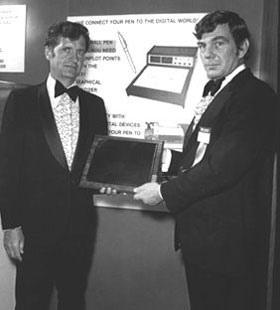
Today's touch screens are divided into several types depending on the physical principle: resistive (four, five or vosmiprovodnye), capacitive, projective-capacitive, matrix screens on the basis of surface acoustic waves, optical strain and screens based on infrared rays .
Proprietary name technology even more - a few dozen. The most widely used resistive and capacitive screens, and the rest are either obsolete or highly specialized.
Resistive Screen
The most easy to implement the type of screen is a four-wire resistive. It consists of a glass panel and flexible plastic membrane, onto which a thin conductive coating. The space between the glass and the membrane is filled mikroizolyatorami reliably insulating conductive surface. Along the edges of each layer set thin metal plates - electrodes. In the back layer with the resistive material are disposed vertically and in the front - horizontally, it is necessary to calculate the coordinates. When the screen is pressed, the panel and the membrane are closed, a sensor detects the change in resistance at the point of pressing and converts it into a signal. Improved variation are vosmiprovodnye touchscreens. Their accuracy is higher, but the reliability and durability of a limp.
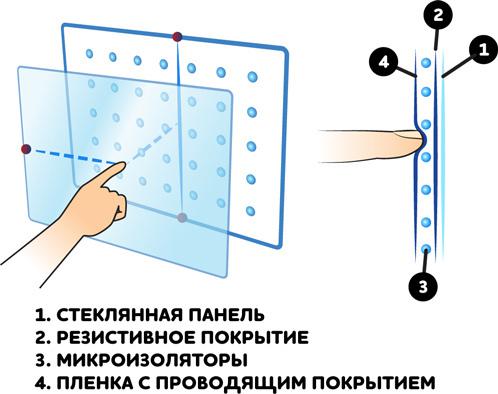
Five-wire screen is more reliable due to the fact that the resistive coating on the membrane is replaced by a conductive, which will continue to operate even with a damaged membrane. On the rear glass is coated with four electrodes at the corners, which are constantly under stress. But the fifth electrode is the output of the front conductive layer. As soon as you touch the screen, the upper and lower layers are closed, and the controller will lock the first voltage change on the front layer, that is, the fact of touch. Further, first rear layer two electrodes earthed horizontally, then the other two, but the vertical.
LG Optimus GT 540
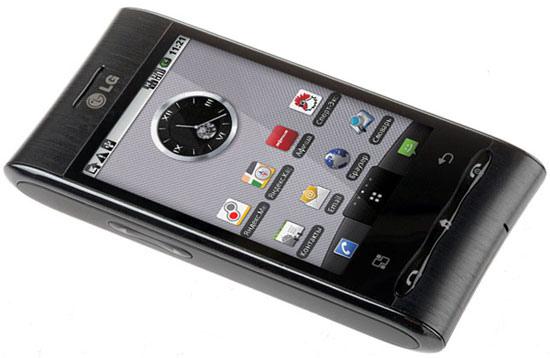
Matrix touch screens
Here the design is very reminiscent of a resistive screen, but is simplified to a disgrace. On the glass coated horizontal wires, the membrane - Vertical. When you touch the screen wires touch and closed crosswise.
The processor keeps track of exactly which conductors are locked, after which easily calculates the coordinates of the click. That's all. These screens have a very low accuracy in comparison with other types of touchscreens, so long do not apply. Matrix can be a panel of buttons located at the crossroads of the conductors.
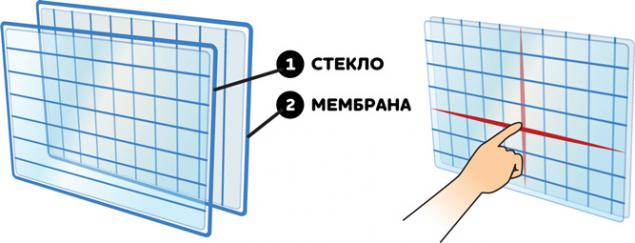
Capacitive touch screens
Capacitive (as surfactants capacitive) screen is more complex and uses the fact that the human body and the screen form a capacitor which conducts alternating current.
This screen is a glass panel coated with a transparent resistive material to provide electrical contact with the body. The electrodes are located on the corners of the screen, the conductive layer is fed to a small alternating voltage. When you touch the screen with your finger or other conductive object is leaking through said AC condenser. The closer to the electrode finger, the smaller the resistance of the screen, and therefore, the current more. All this is detected by sensors that transmit information to the processor for further processing.
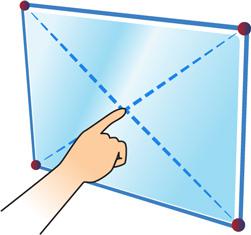
Capacitive touch screens are durable and can withstand up to 200 million clicks. Their accuracy is slightly better than that of the resistor, and the transparency exceeds 90%. However, such displays are afraid of liquids, non-conductive pollution.
iPhone 3G
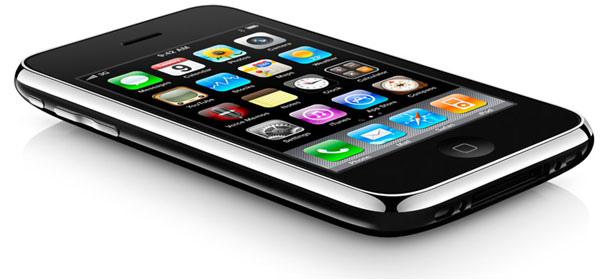
Projection-capacitive touchscreens
But projective-capacitive display supports simultaneous pressing in several places, although they have a more complex structure.
On the inner side of the mesh screen coated electrodes, contact of which is formed a capacitor. In place of formation of the capacitor varies its electrical capacitance, and the controller determines the point of intersection of the electrode. Then everything is as usual - the controller, calculating coordinates.
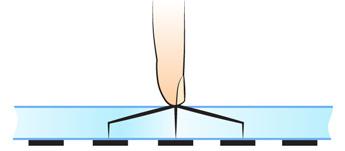
If you touch the screen in different places, then the number of capacitors formed, which gives the opportunity to realize the multi-touch technology.
ipad2

The screen with a grid of infrared rays
The principle of infrared touch panel is simple and is somewhat reminiscent of matrichnyy.Vot just here vertical and horizontal wires are replaced by infrared rays. Around the display passes frame with built-in transmitter and receiver. At the time of the touch display some rays overlap and do not reach their destination - the receiver. Then the controller will not be difficult to calculate the point of contact.
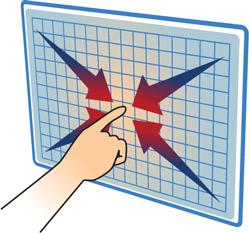
Such displays are perfectly reflect light and extremely durable, because it does not cost sensitive coating. However, they have not very high accuracy and fear of contamination. Currently available in a huge frame with a diagonal of up to 150 inches for use in conjunction with a conventional monitor or projector.
Sony Reader PRS-650

Touchscreens on surface acoustic wave (SAW)
This screen with a frightening name is a glass panel with built at the corners of piezoelectric transducers (PETs). Along the perimeter of the display arranged and reflecting sensor. The controller generates high-frequency signals and sends it to the probe. That, in turn, converts the signal into acoustic oscillations, which are reflected by the reflective sensor. Then reflected waves trapped receivers and again sent to the PEP to convert back into an electrical signal. When you touch the screen with your finger portion of the energy is absorbed by the acoustic waves. Receivers capture this change and complex processor calculates the position of the contact point.
The main advantage of the screen to the surfactant is able to track not only the coordinates of the point, but the pressure control, thanks to the fact that the degree of absorption of ultrasonic waves depends on the pressure at the point of tangency. This device has a very high transparency, since the map image on the screen comes without any obstacles in the form of conductive layers, as in resistive screens. Such screens are difficult to implement, but is quite durable. They can withstand up to 50 million touches, and are often used in gaming machines in the protected reference systems and educational institutions. The main drawback of the screen on the surfactants are malfunctions in the presence of vibration and noise, as well as contamination of the screen.
ALL
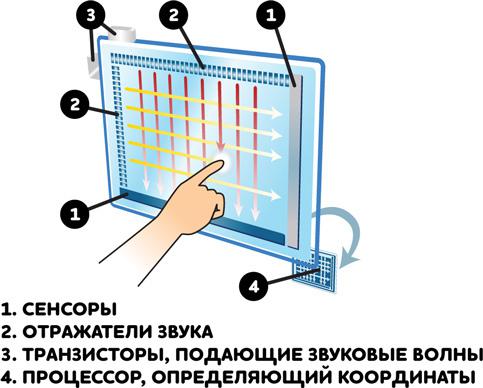
Source:
12 photos
source

Touch Screen - coordinate input device responsive to touch. Most often, they replace a whole bunch of mechanical buttons, which certainly is convenient, since it combines and the display and input device. The absence of moving mechanical parts and options increases the reliability of such a system.
The first semblance of a touch screen appeared in the late 60-ies of the last century, when the American scholar Samuel Hurst faced with the need to read the tape recorders kilometers. In 1971 he founded the company Elotouch, which released elograf - the first computing device with a resistive touch screen. A little later, his company has teamed up with Siemens and was named Elographics. The fruits of this collaboration was the development of the touch panel for existing CRT. In 1982 the company introduced the world's first touch-screen TV.

Today's touch screens are divided into several types depending on the physical principle: resistive (four, five or vosmiprovodnye), capacitive, projective-capacitive, matrix screens on the basis of surface acoustic waves, optical strain and screens based on infrared rays .
Proprietary name technology even more - a few dozen. The most widely used resistive and capacitive screens, and the rest are either obsolete or highly specialized.
Resistive Screen
The most easy to implement the type of screen is a four-wire resistive. It consists of a glass panel and flexible plastic membrane, onto which a thin conductive coating. The space between the glass and the membrane is filled mikroizolyatorami reliably insulating conductive surface. Along the edges of each layer set thin metal plates - electrodes. In the back layer with the resistive material are disposed vertically and in the front - horizontally, it is necessary to calculate the coordinates. When the screen is pressed, the panel and the membrane are closed, a sensor detects the change in resistance at the point of pressing and converts it into a signal. Improved variation are vosmiprovodnye touchscreens. Their accuracy is higher, but the reliability and durability of a limp.

Five-wire screen is more reliable due to the fact that the resistive coating on the membrane is replaced by a conductive, which will continue to operate even with a damaged membrane. On the rear glass is coated with four electrodes at the corners, which are constantly under stress. But the fifth electrode is the output of the front conductive layer. As soon as you touch the screen, the upper and lower layers are closed, and the controller will lock the first voltage change on the front layer, that is, the fact of touch. Further, first rear layer two electrodes earthed horizontally, then the other two, but the vertical.
LG Optimus GT 540

Matrix touch screens
Here the design is very reminiscent of a resistive screen, but is simplified to a disgrace. On the glass coated horizontal wires, the membrane - Vertical. When you touch the screen wires touch and closed crosswise.
The processor keeps track of exactly which conductors are locked, after which easily calculates the coordinates of the click. That's all. These screens have a very low accuracy in comparison with other types of touchscreens, so long do not apply. Matrix can be a panel of buttons located at the crossroads of the conductors.

Capacitive touch screens
Capacitive (as surfactants capacitive) screen is more complex and uses the fact that the human body and the screen form a capacitor which conducts alternating current.
This screen is a glass panel coated with a transparent resistive material to provide electrical contact with the body. The electrodes are located on the corners of the screen, the conductive layer is fed to a small alternating voltage. When you touch the screen with your finger or other conductive object is leaking through said AC condenser. The closer to the electrode finger, the smaller the resistance of the screen, and therefore, the current more. All this is detected by sensors that transmit information to the processor for further processing.

Capacitive touch screens are durable and can withstand up to 200 million clicks. Their accuracy is slightly better than that of the resistor, and the transparency exceeds 90%. However, such displays are afraid of liquids, non-conductive pollution.
iPhone 3G

Projection-capacitive touchscreens
But projective-capacitive display supports simultaneous pressing in several places, although they have a more complex structure.
On the inner side of the mesh screen coated electrodes, contact of which is formed a capacitor. In place of formation of the capacitor varies its electrical capacitance, and the controller determines the point of intersection of the electrode. Then everything is as usual - the controller, calculating coordinates.

If you touch the screen in different places, then the number of capacitors formed, which gives the opportunity to realize the multi-touch technology.
ipad2

The screen with a grid of infrared rays
The principle of infrared touch panel is simple and is somewhat reminiscent of matrichnyy.Vot just here vertical and horizontal wires are replaced by infrared rays. Around the display passes frame with built-in transmitter and receiver. At the time of the touch display some rays overlap and do not reach their destination - the receiver. Then the controller will not be difficult to calculate the point of contact.

Such displays are perfectly reflect light and extremely durable, because it does not cost sensitive coating. However, they have not very high accuracy and fear of contamination. Currently available in a huge frame with a diagonal of up to 150 inches for use in conjunction with a conventional monitor or projector.
Sony Reader PRS-650

Touchscreens on surface acoustic wave (SAW)
This screen with a frightening name is a glass panel with built at the corners of piezoelectric transducers (PETs). Along the perimeter of the display arranged and reflecting sensor. The controller generates high-frequency signals and sends it to the probe. That, in turn, converts the signal into acoustic oscillations, which are reflected by the reflective sensor. Then reflected waves trapped receivers and again sent to the PEP to convert back into an electrical signal. When you touch the screen with your finger portion of the energy is absorbed by the acoustic waves. Receivers capture this change and complex processor calculates the position of the contact point.
The main advantage of the screen to the surfactant is able to track not only the coordinates of the point, but the pressure control, thanks to the fact that the degree of absorption of ultrasonic waves depends on the pressure at the point of tangency. This device has a very high transparency, since the map image on the screen comes without any obstacles in the form of conductive layers, as in resistive screens. Such screens are difficult to implement, but is quite durable. They can withstand up to 50 million touches, and are often used in gaming machines in the protected reference systems and educational institutions. The main drawback of the screen on the surfactants are malfunctions in the presence of vibration and noise, as well as contamination of the screen.
ALL

Source:
Tags
See also
Pheromones: How it works
Fake eggs from China: how to do it and how to spot a fake
Ability to accept gifts.
How to do it: Work on the travel agency
As I worked in India, web developer under contract
"Smart" appliances: how does it work?
From the series "How to do» | Books from Tver
Children adjustment: how it was (136 photos)

















